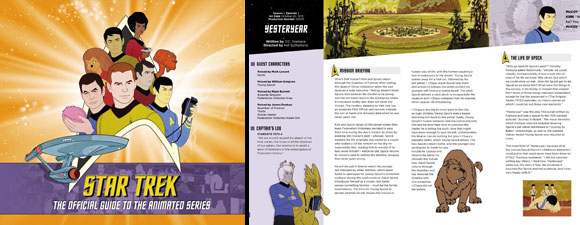Retro Review: The Slaver Weapon
5 min readSpock, Uhura and Sulu are captured by the Kzinti, a dangerous enemy trying to collect the ancient technology of the Slavers.
Plot Summary: Spock, Sulu, and Uhura have taken a shuttlecraft to bring an extremely rare Slaver stasis box to a starbase when the box begins to glow. Spock and Uhura discuss how the Slavers conquered the known universe nearly a billion years earlier, but died in the same war that killed their conquests. Spock adds that because time stands still inside a stasis box, any artifacts left remain precisely as they were millions of years earlier. He decides that they must risk diverting from their course to see if another box in the area has made theirs react. On a frozen world, they detect a stasis box beneath the ice, but it is a trap laid by the Kzinti, who originally discovered the box now held by the Enterprise crew. Though the Kzinti box is an empty museum relic, they use it to open the other and find what appears to be a weapon. Sulu reminds the Kzinti that they lost all their previous battles with humans but the Kzinti are determined to learn how to use this new weapon to destroy humanity. Because Uhura is a woman and Spock an herbivore, the Kzinti do not consider them threats, which allows the crewmembers to escape. The weapon has several innocuous settings and one deadly one, and when the Kzinti try to force it to destroy their enemies, it instead self-destructs, destroying the Kzinti raiders and their ship. As the officers return to the shuttlecraft, Sulu says he’s sorry the device can’t be studied, but Spock calls the weapon too dangerous, observing that a relic from an ancient war nearly sparked a modern war.
Analysis: “The Slaver Weapon” is quite a famous episode among science fiction fans because it incorporates writer Larry Niven’s Kzinti, who were created in Niven’s Known Space series and shared among a group of science fiction writers all interested in the fictional conflict between humans and the Kzin. I didn’t read much of the Known Space material – you can imagine my disgust toward a race whose females are considered “dumb animals” and who are slaughtered as little girls if they reveal intelligence – so I can’t evaluate the episode’s contribution to Kzinti lore, only to the Star Trek universe, where I’d have to describe it as okay but not great. It’s certainly better thought out than “The Lorelei Signal” or “The Magicks of Megas-tu,” and it’s enjoyable to see Spock in command of a relatively successful shuttle crisis while Sulu and Uhura get to have some fun off the bridge, but there’s no interesting development of the regular characters and we get only a teasing glimpse of the great ancient civilization of the Slavers, from whom one would rather expect more interesting artifacts than turn up in the particular stasis box opened by the Kzinti.
Though the Slavers are new to the Star Trek universe, they are made immediately relevant as we’re told that their technology from stasis boxes enabled the development of the artificial gravity used on starships. Since the inertial dampers are one of many near-magical devices impossible to current science that the crew uses constantly, like the transporters and replicators, this is actually a reasonable explanation for how humanity achieved so much and became a dominant species in the galaxy in just a few hundred years: we didn’t invent everything, we found it and adapted it from someone else! Unfortunately, of the two Slaver boxes mentioned in this episode, the contents of one is missing while the other contains only poisoned meat, the first-known-to-Starfleet photo of a Slaver (one-eyed and green), and the odd device that everyone seems sure must be a weapon though it has several other uses as well: it can be converted into a telescope, it can fire a harmless laser, it can be used as a jet pack, and it can suppress energy fields, which allows Spock and his team to escape while the Kzinti are busy trying to figure out where the higher settings might be. Sulu makes the rather clever assumption that the weapon must have been designed for espionage, since it has settings that would be useless to a soldier, which makes Sulu and Spock guess that the device likely has a self-destruct setting. Although Spock gives lip service to the fact that he thinks Uhura is intelligent even though the Kzinti treat women like animals, she gets shot twice and taken hostage when Spock and Sulu could otherwise have made it into space with the weapon, and other than recounting some Kzinti history, she doesn’t get much to do besides lament the cold and her failings as a sprinter.
We get some tantalizing glimpses of Kzinti society, such as the fact that some Kzin are mind-readers but those don’t appear to be the ones with the most power since they tend to be neurotic, and that they’ll have more respect for Sulu if he flaunts the fact that he’s a meat-eater. They admire his bravery when he doesn’t flinch from the Slaver laser, not realizing intially that it’s because he can see at once that it’s not a serious threat. It’s hard to get a sense of how dangerous the Kzinti might be in combat, since Spock disables their captain relatively easily and since they appear in animation as large purple bipedal cats, but they certainly don’t seem very bright; the Romulans could eat them for dinner if the Romulans ate bipedal cats. Apparently Kzinti honor works rather like Klingon honor in that their captain can’t call for reinforcements because Spock kicked his butt in combat, so his priority is not even retrieving the weapon (he makes no serious threats to Uhura to make this happen) but challenging the herbivorous pacifist to a duel, which Sulu is clever enough to reject. The crucial deadly setting on the Slaver weapon, which Spock says completely converts matter to energy, creates an explosion that looks like a nuclear detonation yet apparently creates no radiation since he witnesses it without ill effects.
“The Slaver Weapon” feels like part one of something – or maybe more like part three of something, since we get the human-Kzinti wars summarized in two sentences and never get a full picture of when people first discovered the Slaver stasis boxes or what they’ve allowed us to do. It’s interesting – at least, if you aren’t too infuriated to learn that there’s a species out there who make the Ferengi, Klingons, Orions, et al look like radical feminist societies – but there’s lots of exposition dropped in dialogue by the only three crewmembers who appear, and it ends very abruptly and violently, with all the Kzinti apparently dead. I’ll tell the truth: I’d rather have a more fluffy episode with Kirk and McCoy around to provide occasional comic relief.







Read the Known Universe Books by Niven. You wont be sorry. Start with The World of Ptaavs.
In the Known Space universe, the Kzin were deliberately manipulated into several wars with Humans, all of which they lost, by the Pierson’s Puppeteers in order to “tame” the Kzin by removing the most warlike (and therefore the most likely to be killed in combat) from the Kzinti gene pool. The Puppeteers (so named not because of their actions but because their “hands/mouths” — separated by the brain case within their bodies) made them look like like Cecil the Sea Serpent from Beany and Cecil) are extraordinary long-term planners, capable of manipulating the politics, economics, even the gene pools of other races, the unintended second meaning of Puppeteer.
I read the Alan Dean Foster “Log” only yesterday; curious that thiswas posted almost the same time, allowing for UK and other timezones. I thought the episode read better than it looked, but thanks for the insights, Michelle.
This episode is the Niven short story known as The Soft Weapon. Spock, Uhura, and Sulu were directly subbed in for the Puppeteer and two humans in the story. No other modifications were made to the story at all. It has absolutely nothing to do with Federation or anything. You’d be far better off to imagine it as them reenacting the story in the holodeck that doesn’t exist yet.
I loved this episode, even if it didn’t feel much like a Star Trek episode, just because I really like the Known Space universe and it was great to see it come to life.
I haven’t read much Niven so far, but I’ve read Ringworld, and I recommend it. It’s pretty high on the “hard” end of sci-fi — three crazy new concepts per chapter, with an average of one and a half making sense — but the characters still get enough attention to be well-defined and interesting. (I want to be Louis Wu when I’m 200.) Plot does get short shrift, which is probably why I had the book for a few years before I made the effort to get all the way through, but it was well worth it.
You should definitely check out Ringworld if you’re curious about Niven’s work, MEG. I think you’ll like it. It touches only briefly on Kzin sexual politics, so that shouldn’t deter you. Hey, if I can stomach the sexual politics of Earth in Niven’s future…
I liked the episode. It was good to have some real sci-fi in Star Trek for a change. I also liked it that Sulu and Uhura had something to do in an episode for once.
This episode reminds me of the one in TOS with Gary 7 where it wasn’t Kirk and co who saved the day.
And I also like catch-all as is pointed out in the review that humanity may have ‘discovered’ a lot of their 23rd century technology.
I think “The Slaver Weapon” is far better than you give it credit… and think how incredible it could have been given a full hour! It is interesting to note this is the only episode of “Star Trek” where Captain Kirk is not in the story.
The animated series took a lot of risks that most cartoons of its period would not have. As you pointed out, the ending is rather violent. Sometimes I think the sugar-coated fare of Saturday morning TV does our kids no favors.